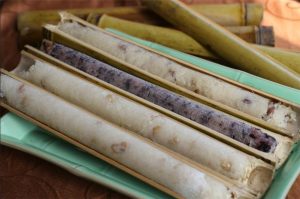 alt="Market Days in Menglian and Townships, Puer"
/>
alt="Market Days in Menglian and Townships, Puer"
/>
Fragrant Couch-Grass Barbecue and Fragrant Bamboo Rice by Dai Ethnic Minority

The Long Dragon FeastXishuangbanna, which is known as “the kingdom of plants”, is also a flourishing place of rice production. Clever and skillful Dai women make use of rice to cook various kinds of staple food. They tread on Mu Dui (a wooden tool) to pestle paddy, once a day, only enough for use of that day. It is a custom that the Dai people do not eat rice cooked the previous day. From November to the next February, it is the season of the Fragrant Bamboo’s maturity, also the best time to enjoy the Fragrant Bamboo Rice. The Fragrant Bamboo is a kind of thin bamboo with long joints, which is called “Maihaola” in Dai, meaning rice-cooking bamboo. It is called the Fragrant Bamboo because of a layer of fragrant film in the stem. To make Fragrant Bamboo Rice, the first step is to cut the bamboo in segments, each segment with a joint at the bottom. Then put rice, which has been soaked in clean water, into the segments, and plug the openings with palm leaves. Now have the bamboo segments smoldered on a charcoal fire, until the inducing fragrance flies out. Take out the bamboo segments and knock them, making the rice soft and loose from the inner wall of the bamboo.
A Traditional Oil ExtractorLastly, cut the bamboo segments open, and there is fragrant bamboo rice with milky bamboo film. Beside, rice pounded into powder or grinded into thick liquid, can be used to cook various kinds of Baba (a kind of rice food). Rice liquid, added with Shizi Flower powder, gingili, peanuts and brown sugar, is to be wrapped up with palm leaf and then steamed, to make what is “Haonuosuo” in Dai, meaning Shizi Flower Baba. It has a color of dark reddish brown, and is savory and sweet, which can also be dried in the sun, cut into thin pieces, and fried in the oil. “Haobeng” means soaked cake in Dai. Mix pounded rice powder with brown sugar, yolk and gingili together, and make small thin cakes, which should be aired. Before eating, roast them on fire first; in this case the cakes will bulge, and be more crisp and delicious. There is still another kind of Baba, made of cooked sticky rice and other condiments, called “Haoji’a” in Dai. This kind of Baba can be eaten fresh, roasted, as well as chipped and fried. Besides, Rice can also be cooked into such staple food as Bajiao Zong, Rou Zong, Mixian, Migan, etc., and also fragrant and sweet sticky rice wine.

pineapple rice and chicken cooked in bambooThe Dai cuisine pays special attention to “sourness, hotness and fragrance”, using such main cooking methods as steaming, roasting, pickling and chopping. Steamed food usually involves chopping the staple, being wrapped in palm leaves and steamed in steam box, such as steamed pork, steamed pig brain and steamed meat and bamboo shoot. Roasted dishes mostly take fragrant couch grass as condiments. Fragrant couch grass is a herbage plant, with the function of adding fragrance and wiping off fishy smell. There are many dishes in this cooking method, such as roasted fish, roasted meat, roasted chicken, roasted bamboo shoot, roasted mushroom, etc. Some roasted food can be made into those with fillings, for instance roasted fish: put prepared condiments into the fish belly, wrap the fish with fragrant couch grass, and then roast it on charcoal fire. It is savory and crisp, and wonderfully delicious. Most pickled dishes are sour, of various kinds, like pickled tendons of beef, pickled oxhide, pickled pig heads, pickled pig hoofs pickled fish, pickled bamboo shoots, etc. Usually they are pickled after having been cooked, and immediately eaten after taken out, going quite well with wine.
Some are also pickled raw, and roasted before eating. The last one, chopping, used to refer to chopped raw materials, like chopped raw beef, chopped raw venison, chopped raw rice field eel, etc. Firstly chop the raw material into chips, then mix it with salt, shallot, garlic, pepper powder, coriander, and wild Chinese prickly ash, and lastly add lemon juice into it. Some people also add pork skin that has been cooked only into milky color. Nowadays, considering the problem of sanitation, it has basically been replaced by cooked materials.

 7 Days GolfingTour
7 Days GolfingTour
 8 Days Group Tour
8 Days Group Tour
 8 Days Yunnan Tour
8 Days Yunnan Tour
 7 Days Shangri La Hiking
7 Days Shangri La Hiking
 11 Days Yunnan Tour
11 Days Yunnan Tour
 6 Days Yuanyang Terraces
6 Days Yuanyang Terraces
 11 Days Yunnan Tour
11 Days Yunnan Tour
 8 Days South Yunnan
8 Days South Yunnan
 7 Days Tea Tour
7 Days Tea Tour
 8 Days Muslim Tour
8 Days Muslim Tour
 12 Days Self-Driving
12 Days Self-Driving
 4 Days Haba Climbing
4 Days Haba Climbing
 Tiger Leaping Gorge
Tiger Leaping Gorge
 Stone Forest
Stone Forest
 Yunnan-Tibet
Yunnan-Tibet
 Hani Rice Terraces
Hani Rice Terraces
 Kunming
Kunming
 Lijiang
Lijiang
 Shangri-la
Shangri-la
 Dali
Dali
 XishuangBanna
XishuangBanna
 Honghe
Honghe
 Kunming
Kunming
 Lijiang
Lijiang
 Shangri-la
Shangri-la
 Yuanyang Rice Terraces
Yuanyang Rice Terraces
 Nujiang
Nujiang
 XishuangBanna
XishuangBanna
 Spring City Golf
Spring City Golf
 Snow Mountain Golf
Snow Mountain Golf
 Stone Mountain Golf
Stone Mountain Golf












 What Our Customers Say?
What Our Customers Say?
